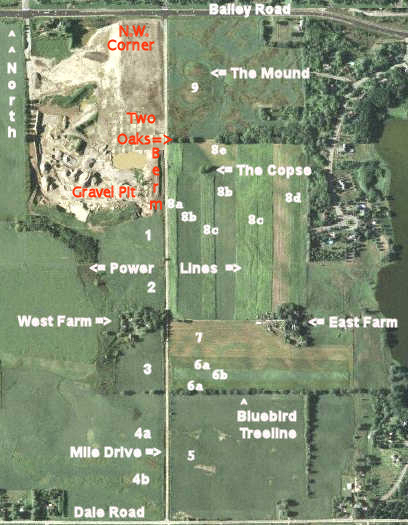
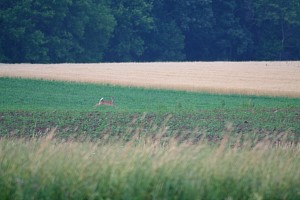 At twilight a deer runs across the corn in Field #8.
Return to Animals
At twilight a deer runs across the corn in Field #8.
Return to Animals
|
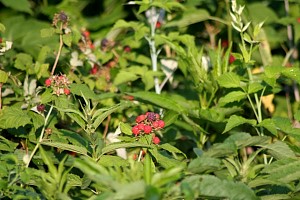 Ripening blackberries - don't eat them while they are red.
Ripening blackberries - don't eat them while they are red.
|
|
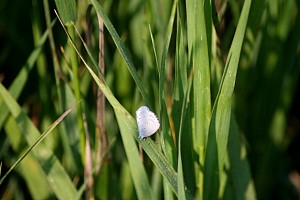
‘Summer’ Spring Azure (Celastrina ladon neglecta) is much whiter below than
‘Spring’ Spring Azure. These butterflies hatch two broods. A first brood in June and a second
brood in late summer.
Celastrina ladon, with its numerous variations and forms, is a very complicated species
that is not yet fully understood. Prior to 1970, most experts agreed that one species of
Celastrina occurred in North America; now three species are recognized.
|
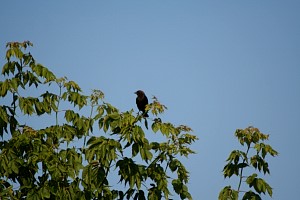 Male Brown-headed Cowbird (Molothrus ater). The Brown-headed Cowbird gets its name
from its strategy of following buffalo, horses,
cattle, or sheep to eat insects kicked up by the herd.
Brown-headed Cowbirds are brood parasites that have completely abandoned the tasks of building nests, incubating eggs, and caring for hatchlings. Instead, each female deposits as many as 40 eggs per
year in nests that belong to other bird species.
She typically chooses a nest with eggs smaller than her own and lays a single egg quickly once the host has also started laying eggs. Cowbird nestlings typically out-compete their smaller nest mates.
Most species will abandon their nest if the cowbird egg is laid first. Some species recognize and reject cowbird eggs, while others appear unable to distinguish either egg or nestling from their own legitimate offspring. When the egg is recognized but the host species is too small to remove the egg, the nest may be abandoned, or new nest material may be placed over the cowbird egg, insulating it from being incubated.
Return to Birds
Male Brown-headed Cowbird (Molothrus ater). The Brown-headed Cowbird gets its name
from its strategy of following buffalo, horses,
cattle, or sheep to eat insects kicked up by the herd.
Brown-headed Cowbirds are brood parasites that have completely abandoned the tasks of building nests, incubating eggs, and caring for hatchlings. Instead, each female deposits as many as 40 eggs per
year in nests that belong to other bird species.
She typically chooses a nest with eggs smaller than her own and lays a single egg quickly once the host has also started laying eggs. Cowbird nestlings typically out-compete their smaller nest mates.
Most species will abandon their nest if the cowbird egg is laid first. Some species recognize and reject cowbird eggs, while others appear unable to distinguish either egg or nestling from their own legitimate offspring. When the egg is recognized but the host species is too small to remove the egg, the nest may be abandoned, or new nest material may be placed over the cowbird egg, insulating it from being incubated.
Return to Birds
|
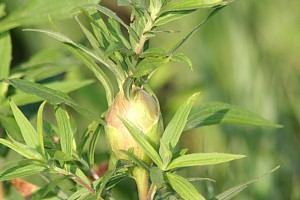
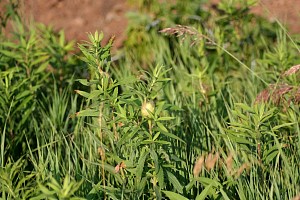
In January I showed a gall -
the swollen, ball-like protrusions on the
plant.
Galls are formed by the reaction of the stem of plants (goldenrod is one)
to the larvae of peacock flies. Larvae are laid in the stem in the summer.
The plant reacts to the invader by forming the gall. The larvae feed on the
plant and gain protection from some predators. The
larvae hatch into flies next spring and the cycle repeats.
|
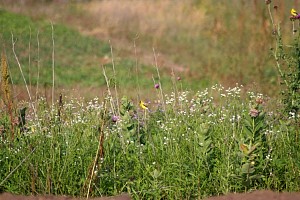
American Goldfinches on nodding thistle. Enlarge this and, Where's Waldo-like, find the second goldfinch.
|
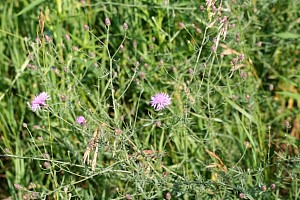
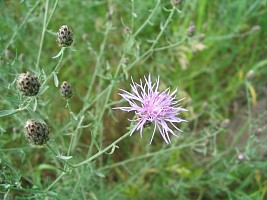 Spotted Knapweed (Centaurea maculosa).
Spotted knapweed was introduced from Eastern Europe into North America in the early 1900s as a contaminant in crop seed.
Spotted knapweed aggressively invades pasture, rangeland and fallow land and causes a serious decline in forage and crop production. The weed is a prolific seed producer with 1000 or more seeds per plant. Seed remains viable in the soil five years or more, so infestations may occur a number of years after vegetative plants have been eliminated. Spotted knapweed has few natural enemies and is consumed by livestock only when other vegetation is unavailable. The plant releases a toxin that reduces growth of forage species.
Return to Flora
Spotted Knapweed (Centaurea maculosa).
Spotted knapweed was introduced from Eastern Europe into North America in the early 1900s as a contaminant in crop seed.
Spotted knapweed aggressively invades pasture, rangeland and fallow land and causes a serious decline in forage and crop production. The weed is a prolific seed producer with 1000 or more seeds per plant. Seed remains viable in the soil five years or more, so infestations may occur a number of years after vegetative plants have been eliminated. Spotted knapweed has few natural enemies and is consumed by livestock only when other vegetation is unavailable. The plant releases a toxin that reduces growth of forage species.
Return to Flora
|
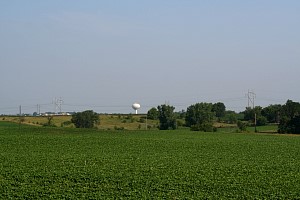
View across the soybeans of Field #3.
|
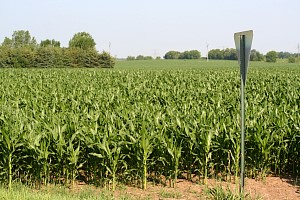
Knee high corn in Field #4. This year we are ahead of "knee high by the fourth of July".
|
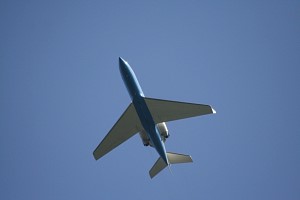
I can't find out the name of this distinctive aircraft - notice the twin jet engines
are not abreast the tail, but seem to be mounted higher near the top of the cabin body.
|
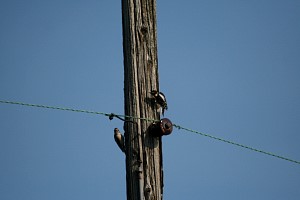
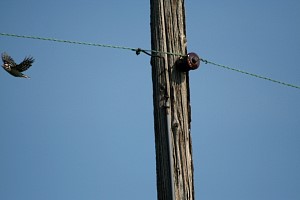
Downy Woodpeckers - the red patch on the back of the head indicates a male. Enlarge the picture
at the right and note the checkered pattern on the wings.
Return to Birds
|
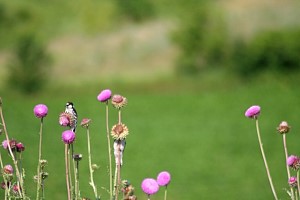
A Downy Woodpecker sitting on nodding thistle, like American goldfinches also do.
|
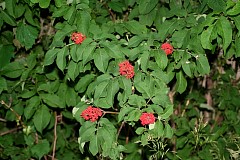
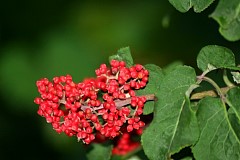
*** 2007 UPDATE ***
A picture of elderberries under Twin Oaks. I didn't get a good picture of them in 2006.
|